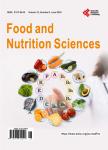Effect of Sodium Metabisulphite on Blood Metabolic Status of Wistar Rats
Effect of Sodium Metabisulphite on Blood Metabolic Status of Wistar Rats作者机构:école de Nutrition Université de Moncton Moncton Canada Laboratoire de Biotoxicologie Département de Biologie Faculté des Sciences de la Nature et de la vie Université D Liabés Sidi Bel Abbés Algérie
出 版 物:《Food and Nutrition Sciences》 (食品与营养科学(英文))
年 卷 期:2014年第5卷第15期
页 面:1529-1537页
学科分类:1002[医学-临床医学] 100214[医学-肿瘤学] 10[医学]
主 题:Sodium Metabisulphite Subchronic Haematology Biochemistry Physiology Wistar Rat
摘 要:The objective of this work was to determine the sodium metabisulphite (NaMBS) subchronic toxicity used as a food additive in Algeria. Three groups of female Wistar rats were treated with 0.25%, 1% and 4% of NaMBS in their drinking water for 90 days. An immunization protocol was conducted during the experiment. Mortality, comportmental and weight modifications, and food and water consumption were recorded. At the end of the experiment, the control and experiment rats were killed, and their blood and organs were removed. Immunoglobulin levels were evaluated;biochemical and hematological parameters were investigated. Our results showed that the administration of NaMBS at 1% and 4% had significant effects on body weight, food and water consumed. There was an increase in biochemical parameters (calcium, urea, creatinine, uric acid, transaminases) and decrease immunoglobulin levels. The hematology revealed a decrease in red blood cells and hemoglobin, as well as leucocytosis. Physiological study showed enlarged spleen, kidney, liver and stomach. In light of our results, we can conclude that subchronic intake of NaMBS 1% and 4% seems to alter immune function, biochemical, hematological and physiological para-meters in Wistar rats.



